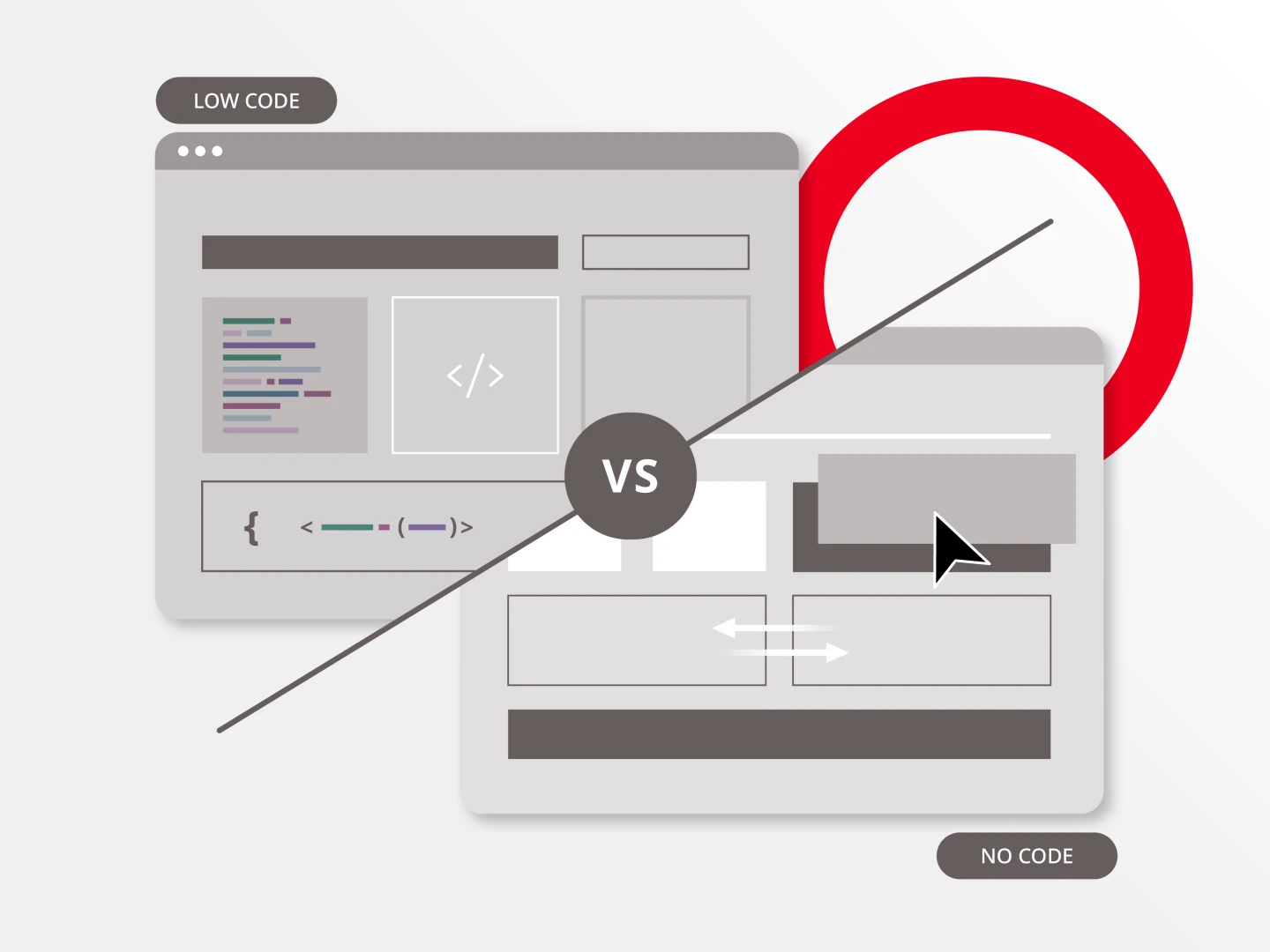As the old saying goes, “work smarter, not harder.” To an extent, this adage is at the heart of software development—make things automated or add intuitive interfaces so that a greater pool of employees (and not just developers) can accomplish a task. Once this happens, organizations can generally operate more efficiently, and this obviously benefits the bottom line.
This approach, and specifically its manifestation through easy-to-use user interfaces, is the idea behind low-code and no-code platforms. With each, organizations don’t have to lean as heavily into development to operate. Instead, less technical and editorial staff members can perform these tasks, which is especially important when it comes to content management systems.
When the low-code platform market first began to explode, developers were afraid. They feared that low-code platforms would replace their jobs and had concerns they weren’t suited to handle mission-critical tasks. But neither of these fears materialized. In fact, most low-code platforms are very reliable tools that support developers in their ability to respond quickly and be more agile. Now, we believe these platforms will become increasingly critical to the success of development teams.
Forrester defines low-code platforms as, “Platforms that enable rapid delivery of business applications with minimum hand-coding and minimal upfront investment in setup, training, and deployment.” In today’s digital-first environment, companies want to be increasingly responsive, which has been a huge driver in the growth of the low-code platform market.
Low-code platforms empower development teams to play a vital role in enabling businesses to change quickly, with minimal mistakes. According to Salesforce’s Top Trends in Low-Code Development, “Low-code development has the potential to transform the critical relationship between IT and business units and empower quick innovation in a new digital era.”
When you think about future-proofing and being prepared for what is coming next, I think it is about finding ways to utilize no code and low code options that empower your content teams and free up developer teams to focus on revenue impacting organizational priorities. This has got to be a pretty critical focus for development leaders so they can keep their powder dry for when they really need it.
To low-code or not
Low-code platforms become incredibly valuable for development teams that are pressured to turn around sprints and projects at lightning-speed. Though there is still a place for hand coding, low-code solutions increase productivity because they automate both simple and complex tasks (e.g. writing boilerplate code), empowering dev teams to work smarter and faster.
Low-code platforms are especially beneficial to both development and business teams because they:
- Are more cost effective
- Enable rapid time-to-market by streamlining the development and implementation of both ideas and technology
- Empower business users to make changes to digital strategies, since development expertise isn’t often required
- Place a lighter operational burden on development and IT teams because vendors handle hosting and maintenance, also easing the burden of IT backlogs
In the same report, Salesforce found that 63 percent of IT leaders “believe that low-code development will positively impact the software development cycle, enabling business users to deploy applications more quickly.” The synergy created between business users and IT to deliver applications more quickly allows companies to pivot and adapt to market changes.
Finding the right low-code platform
Not all low-code platforms are created equally. Some low-code platforms are packed with features, but because of inflexible architecture, prevent companies from customizing the platform to meet their business needs or develop necessary integrations that don’t come out-of-the-box.
When evaluating new low-code platforms, ask the following questions before making a purchase decision:
- Can the platform support our workload?
- Does the platform have a strong support community actively maintained by partners or the platform architects?
- Is this platform interoperable and can it support the integrations we need?
- Is the architecture of the platform flexible enough to evolve and scale with our changing business needs?
If the answers to any of the above questions are “no,” it’s best to move on. Companies should invest in low-code platforms that offer great functionality out-of-the-box, but can integrate within established tech stacks and be customized if needed. This alleviates the need for development hacks, which ultimately defeat the purpose of the investment in these types of platforms.
The market for low-code platforms is diverse and growing because they expedite the transformation of companies into fully digital businesses. Because the market is maturing, development teams shouldn’t be concerned that low-code platforms will replace them or that they can’t deliver on mission-critical tasks. Rather, both development and business teams should embrace low-code platforms as useful tools that empower them to keep up with changing market and customer demands. Low-code platforms allow development and business teams to start, finish and customize later, which is our favorite motto at Brightspot. We believe flexible and interoperable low-code platforms are invaluable to development teams.
It is not like you start a low code or no code initiative and then there is nothing for your developers to do. What you are gaining is productivity for your developers as now they are focused on things that actually impact your business and not just the tables stakes of building a content management system or the framework that provides your editors the ability to do the customizations that they need to do.
Examples of low-code and no-code platforms
Conveniently, Brightspot is a no-code platform with low-code options, depending on what an organization needs.
Brightspot requires essentially no code. Everything an organization would ever need to launch a new site or app more quickly than with any other product is available to them right from the start. In a few mouse clicks, editors can make their own content types to fit their use cases, and Brightspot automatically generates the corresponding user interfaces so content teams can begin right away. Workflows are instantly available to guide a piece of content to the right eyes before publishing. Documents, spreadsheets and other kinds of assets can be loaded directly into the CMS for easy distribution across an organization. Newsletters can be generated quickly and used to engage audiences. All of this is without code.
Brightspot’s theming engine is where it gets really interesting, though. The theme engine, by default, requires no code; however, to better cater to customers who may want to do their own theme development on top of what Brightspot offers, they can.
Brightspot’s theme engine
Brightspot has two theme options.
The first is a suite of pre-built theme packages that leverage decades worth of experience working with technology and publishing companies. These themes have highly customizable attributes, and any user may change the way a site displays content on the front end by making changes to the back end interface.
Things like fonts, button colors, link colors, footers—practically anything—can all be changed in a few mouse clicks, giving users great flexibility. And all without a single line of code.
However, other companies may want even more control.
As a result, Brightspot also supports style packages, comprised of CSS and JavaScript files, where developers can very granularly fine-tune the site to look how their organization needs it to look. While there is code involved in this process, it’s minimal. Users can add these CSS and JavaScript files to a .zip folder and load it into Brightspot, thereby extending the built-in styles and JavaScript that comes with the core front-end platform.
Low-code or no-code? Which should you choose?
As with many things, there is generally no right or wrong answer to this question. It’s all up to the organization and what requirements it has. If it needs a CMS that is so user friendly that their editorial staff members can handle any and all publishing and theme operations, no-code is the way to go. If the organization wants more granular control over some aspects of the platform, low-code platforms may be better.
What’s most important is to find a platform that provides options. What one project might require is not the same as what another project may require. Having a platform that can attack multiple use cases in multiple ways is the best play for the future, given that requirements change frequently. Best, then, to go with a platform that can do it all.
As the name suggests, low-code platforms do not require much coding experience or expertise to accomplish the task at hand, opening up the pool of employees who can accomplish the task to less technical personnel. Developers are still needed to an extent, but not as much as they would be with a platform that didn’t pay as much mind to the principle of “low code.”
It is important to note, though, that the concept of “low code” is subjective. There is no industry-determined nor industry-accepted way to measure what meets the definition of “low code.” Large organizations could have hundreds of thousands of lines of code—which is considerable—but that might be relatively small compared to their competitors.
Similar to low code, the name “no code” is simply that: a platform that doesn’t require any coding experience or expertise whatsoever. These kinds of platforms are fully interfaced, and non-technical personnel can accomplish whatever they need to accomplish without ever having to open a console.
There isn’t a need for development with these kinds of platforms, at least not immediately. Everything that would be accomplished through code can be accomplished through a user interface, broadening the pool of employees who can complete tasks.
As with any business process, the less chance for human error, the better. Developers, as an archetype, are typically highly detail-oriented professionals capable of great things, but we all have rough days. This might mean making an error (or a few) across hundreds of lines of code, causing things to break—but not if there aren’t hundreds of lines of code in the first place.
The less code, the less room for error.
The less code, the less room for security vulnerability, as well. Code that doesn’t need to be maintained and, as a result, can’t be accessed is just that—inaccessible. Hackers will continually try to find ways and weaknesses, but low-code and no-code platforms have a bit of a better baseline defense.








